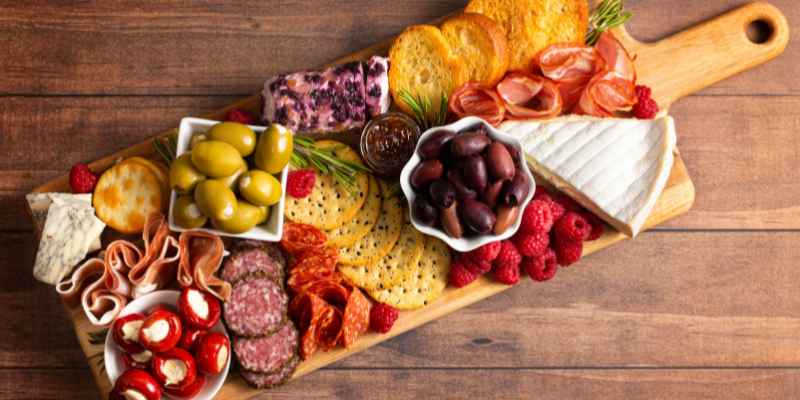The best material to use for sealing a charcuterie board is food-safe mineral oil, which is colorless, odorless and lightweight. It’s important to avoid using other oils, such as olive or avocado oil, as they can become rancid over time.
Charcuterie boards are gaining popularity as a way to present and enjoy a variety of delicious foods. From cheese and charcuterie to fruits and nuts, the possibilities are endless. However, it’s important to properly seal and maintain the board to prevent it from becoming damaged or contaminated.
Using food-safe mineral oil is the best way to protect and preserve the board, as it’s easy to apply and non-toxic. We’ll explore the benefits of mineral oil and provide some tips for maintaining your charcuterie board in top condition.
What To Use To Seal A Charcuterie Board
To properly seal a charcuterie board, a food-safe finish is crucial. Many people choose to use a mixture of mineral oil and beeswax, warmed over low heat and applied in thin, even coats. Other options include cutting board oils and conditioners that are food-grade and safe for use on wooden surfaces.
Sealing a charcuterie board is a necessary step for extending the life of the board and ensuring food safety. While there are many types of sealants available, it’s essential to choose a product safe for food use. Below are some options for sealing your board, each with different benefits:
Food-grade Mineral Oil
Food-grade mineral oil is a popular option for sealing wooden boards because it prevents them from absorbing moisture and bacteria. It’s also affordable and easy to apply. It works by penetrating the wood’s pores, creating a barrier that resists stains and odors. This sealant is also colorless and odorless, so it won’t affect the taste of your food.
Beeswax And Mineral Oil Mixture
A mixture of beeswax and mineral oil is another popular choice for sealing charcuterie boards. It provides a protective coating that can last for several months and is resistant to scuffs and scratches. While beeswax is a natural disinfectant, it is not antimicrobial. Therefore, it’s crucial to use a food-grade mineral oil alongside it. Applying the mixture is simple: melt the beeswax and add mineral oil, then apply the mixture to the board. If needed, repeat the process several times until the desired level of protection is achieved.
Coconut Oil
Coconut oil is a natural sealant that’s both antibacterial and antifungal. It’s also easy to find in stores and has a pleasant fragrance that will not affect the taste of your food. Coconut oil works by filling in the wood’s pores, making it resistant to moisture and bacteria. However, it’s essential to reapply the oil periodically, as it can wear off over time.
Carnauba Wax
Carnauba wax is a natural, plant-based sealant that’s harvested from the leaves of a Brazilian palm tree. It’s a durable, water-resistant, and a natural alternative to synthetic waxes. However, unlike mineral oil, carnauba wax requires more effort to apply. You’ll need to melt the wax and apply it to the board using a clean cloth. Once the wax hardens, buff it to a shine.
Baking Soda And Lemon Juice
A mixture of baking soda and lemon juice can be used to clean and sanitize a charcuterie board. Lemon juice’s acidic nature helps eliminate bacteria and freshen up your board, while baking soda acts as a gentle abrasive to remove stains and odors. After applying the mixture, rinse the board with water and let it dry for several hours.
In conclusion, when selecting a sealant for your charcuterie board, it’s important to choose the right one based on your needs. Consider the level of protection you desire, the ease of application, and the safety of the sealant. By choosing the right sealant for your charcuterie board, you’ll ensure it lasts for years and remains food-safe.
How To Apply The Sealant
When sealing a charcuterie board, it’s important to use a food-grade mineral oil to condition the wood and protect it from damage. Apply the oil in a thin layer and allow it to soak in overnight, then buff off any excess with a clean cloth.
Repeat the process several times until the board is well-sealed and protected.
If you want your charcuterie board to last long, you need to apply a sealant. A sealant will protect your board from moisture and damage, ensuring it remains in great condition for a long time. Applying a sealant is simple and straightforward. Here’s how you can do it in three easy steps.
Cleaning the board:
Before applying the sealant, make sure that you clean the board thoroughly. Use a mild cleaner such as dish soap and water to get rid of any dirt, grime or food particles. Then, rinse the board with water and let it dry completely. You don’t want any moisture on the board before applying a sealant.
Applying the sealant:
Once the board is dry, apply the sealant on the surface of the board using a clean cloth or a brush. You can use either mineral oil, beeswax or a mixture of both to seal the board. Start from one end and work your way to the other end, ensuring that you cover the entire surface evenly. Apply a thin coat and then leave it to dry completely before adding another one.
Buffing the board:
Once you have applied the sealant, leave the board overnight to dry completely. In the morning, use a clean, dry cloth or a buffing wheel to buff the board gently. Buffing will remove any excess sealant, smoothen the surface evenly and enhance the overall appearance of the board.
In conclusion, applying a sealant is important to protect your charcuterie board from any damage and extend its lifespan. Follow these steps carefully to apply the sealant and maintain the board’s appearance and quality.
Alternative Finishes For Wood Charcuterie Boards

Finishing a wooden charcuterie board requires a food-safe sealant. A popular option is a mixture of mineral oil and beeswax, which protects against moisture and bacteria. Other alternatives include special cutting board oils or finishes specifically designed for wooden surfaces.
Charcuterie boards are an elegant addition to any kitchen with diverse design options and versatile usage. The perfect wood charcuterie board, however, cannot merely be made from any wood type or shape as it requires statements and a little maintenance to keep it functional and looking new. One of the critical maintenance steps is sealing the board to protect it from wear and tear, moisture, and bacterial build-up.
Designing your own charcuterie board
Designing your charcuterie board is an exciting experience, and it involves selecting the perfect wood type and shape, which could vary from hardwoods like maple and walnut to bamboo. The focus is to pick a board that has a tight grain and that is free from any abnormalities like knots, as such can make it challenging to seal.
Using board butter
Board butter is one of the simplest finishes that can be used on a charcuterie board. It is a mixture of natural waxes, oils, and food-safe ingredients that help to prevent moisture and keep the board hydrated. Applying board butter to your board about once every month can keep the wood moisturized, strong, and prevent it from warping.
Best cutting board oil finish for woodworking
Cutting board oil is a great finish for wood charcuterie boards as it is food-safe, natural, and helps to prevent moisture and bacterial build-up, which is one of the essential features of any cutting board finish. Some of the top-rated cutting board oils include CLARK’S Cutting Board Oil and Howard Butcher Block Conditioning Oil. Applying a coating of oil to your board about once every three months can keep it looking new and moisturized.
In conclusion, the goal of any charcuterie board finish is to protect the board from moisture, bacteria, and keep it looking beautiful. Choosing the perfect wood type, using board butter as a simple finish, and applying cutting board oil are great ways to ensure that your charcuterie board lasts long and still functions at its best capacity.
How To Care For A Charcuterie Board
To seal a charcuterie board, food grade mineral oil is the best choice as it is colorless, odorless, and lightweight. This helps to protect the board from stains and moisture and keep it looking new for years to come. Beeswax can also be added to the oil for a food-safe finish.
Charcuterie boards are a beautiful addition to any kitchen or dining room. They’re versatile and perfect for parties, snacks, or even for making a meal special. However, it’s important to know how to care for your charcuterie board so it can last for years. In this section, we’ll go over the best ways to care for your charcuterie board, including avoiding oils that can become rancid, seasoning charcuterie boards, and cleaning and storing them.
Avoiding Oils That Can Become Rancid
When it comes to sealing a charcuterie board, many people use oils like coconut oil or linseed oil. However, these oils can become rancid over time and affect the taste of the food. Instead, use food-grade mineral oil to seal your board. Mineral oil won’t go rancid and is safe for food contact. Apply a generous amount to the board and let it soak in for at least 20 minutes. Wipe off any excess oil with a clean cloth.
Seasoning Charcuterie Boards
Before using your charcuterie board for the first time, season it with beeswax and mineral oil. This will help protect the wood and give it a nice shine. You can buy a ready-made board oil or make your own. To make your own, melt 1 part beeswax and 4 parts mineral oil in a double boiler. Once the wax is melted, pour the mixture over the board and spread it evenly with a cloth. Let it sit for at least 24 hours before using it.
Cleaning And Storing The Board
After using the charcuterie board, clean it with warm soapy water and a soft cloth. Avoid using harsh detergents or soaking the board in water, as this can damage the wood. Once the board is clean, let it air dry completely before storing it.
Store your charcuterie board in a dry place where it won’t be exposed to extreme temperatures or humidity. Avoid stacking heavy objects on top of it, as this can also damage the wood. If you want to keep your board looking good as new, condition it every month with mineral oil. Simply apply a small amount of oil to the board and wipe away any excess with a clean cloth.
In conclusion, taking proper care of your charcuterie board is essential if you want it to last for years. By avoiding oils that can become rancid, seasoning the board, and cleaning and storing it correctly, you’ll be able to enjoy your charcuterie board for many parties and meals to come.

Frequently Asked Questions For What Do You Use To Seal A Charcuterie Board
How Do You Finish A Raw Charcuterie Board?
To finish a raw charcuterie board, use a food-safe finish such as a mixture of mineral oil and beeswax. Warm the mineral oil in a saucepan over low heat and add a chunk of beeswax. Use food-grade mineral oil to condition the board and avoid using other oils like avocado or olive oil.
What Should I Treat My Charcuterie Board With?
For treating your charcuterie board, it’s recommended to use food-grade mineral oil. Other oils like avocado or olive oil can become rancid over time. Use FDA-approved food-grade mineral oil as the best cutting board oil for seasoning your charcuterie board.
How Do You Treat Wood For A Charcuterie Board?
To treat wood for a charcuterie board, use food-grade mineral oil. Avoid using other oils like avocado or olive oil as they can become rancid over time. Warm the mineral oil in a pan over low heat and add a chunk of beeswax.
Apply the mixture to the board and buff the surface.
What Is The Best Oil To Finish A Charcuterie Board?
The best oil to finish a charcuterie board is food-grade mineral oil. Using mineral oil and beeswax will also make a safe food-grade finish for the board. Avoid using other oils like olive or avocado oil, as they can become rancid over time.
The best cutting board oil is an FDA-approved food-grade mineral oil.
Conclusion
There are various options to seal a charcuterie board, but the best one is the food-grade mineral oil. It is colorless, odorless, and lightweight, making it the perfect choice for conditioning the charcuterie board. Avoid using any other oil you have on hand, like olive oil or avocado oil.
These oils can become rancid over time. Remember to dampen a soft, lint-free cloth when seasoning your charcuterie board. Proper sealing will not only preserve the board but also ensure that it is safe for food use.


